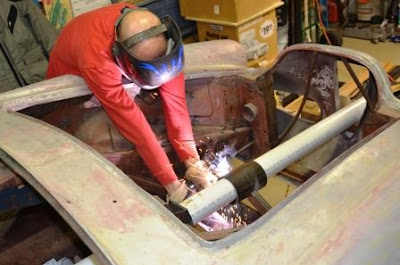The blasting soda still hasn't shown up, but even if it had I couldn't use it today--we've had 30 mph winds all day. So maybe this is a good time to talk about the Alfatross' family history. One of the things that makes the Alfatross and its siblings valuable is rarity. But exactly how rare are they, really? If we start with the available records for how many 1900C Alfa Romeos were clad in Zagato bodies it seems to be between 39 and 42, but there are some discrepancies. The table below is my compilation of the Alfatross' siblings listed by chassis number, year of production, Zagato body number (where known), year it ran in the Mille Miglia, current owner, country of residence, and most recent date of my information about the car. You will notice that for the majority of the cars ownership information is quite out of date (1990) so some will have changed hands over the last 20 years.
The table reveals some interesting details. The U.S. has 7 cars, more than any other country. Most of the cars were produced in 1954 (21), another 14 were produced in 1955, only 3 or 4 were produced in 1956, none in 1957, and 1 or 2 in 1958. Curiously, chassis no. 01931 is listed as an entrant in the 1955 Mille Miglia, but is not listed in Zagato's records as one of its cars. Chassis 01844 is notable for having run in the '55, '56 and '57 Mille Miglia. I also notice that its Zagato body number, 1254, is strangely out of sequence when compared to the other Zagato body numbers that are known. Numbers 40 and 42 are listed as "spyder SSZ," apparently prototypes built for car shows. Sr. Marchiano writes "It seems that both of these cars have disappeared."
Unlike the Alfa Romeo chassis and engine numbers, which are indelibly stamped into steel, the Zagato number is unceremoniously scrawled in pencil on the back side of a plywood trim piece above the windshield. It is very easily lost, so these cars tend to be differentiated by their Alfa Romeo chassis numbers rather than their Zagato numbers, even though the Zagato bodies are what make them unique.
A car with verified racing history is usually valued higher, all things being equal. When I compared the list of chassis numbers bodied by Zagato with cars known to have entered the Mille Miglia, the most famous road race of all time, between '54 and '57 there were only five, but the actual number is likely to be a higher. Mille Miglia records for those years show a lot of entries listed simply as "1900 SSZ," without chassis numbers given. In addition to the 5 known 1900 SSZs entered in 1955 there were 3 listed as "1900Z." In 1956 there were 3 cars listed as "1900 SSZ" and in 1957 there were 4 listed the same way in addition to remarkable car 01844 that ran all three years.
Significantly, only one car, no. 01908, is known to have been destroyed. If the two spyders have disappeared that leaves 39 cars unless number 01931 is the result of a mistake made by Mille Miglia record-keepers, in which case we are downto 38. Fourteen cars have no information available other than that they were bodied by Zagato. Are they still in existence? How many real cars are left? My list shows that only 28 cars are known to exist, but I expect there are others. If anyone out there can help fill in the blanks, I'm sure all legitimate owners would appreciate it. I say legitimate because some say there are a number of "copies" now on the market (see http://www.ar1900reg.org/index.cfm.) known collectively as "fauxgatos."
Imitation is the sincerest form of flattery?
 |
| Alfa Romeo 1900 chassis bodied by Zagato 1954-1958. Information courtesy ot Peter Marshall and Michele Marchiano. |
 |
| These cars were built to race, and race they did! |
Unlike the Alfa Romeo chassis and engine numbers, which are indelibly stamped into steel, the Zagato number is unceremoniously scrawled in pencil on the back side of a plywood trim piece above the windshield. It is very easily lost, so these cars tend to be differentiated by their Alfa Romeo chassis numbers rather than their Zagato numbers, even though the Zagato bodies are what make them unique.
 |
| The Zagato body number for my car. Written in pencil, almost as an afterthought, it says "Alfa No 1209." |
A car with verified racing history is usually valued higher, all things being equal. When I compared the list of chassis numbers bodied by Zagato with cars known to have entered the Mille Miglia, the most famous road race of all time, between '54 and '57 there were only five, but the actual number is likely to be a higher. Mille Miglia records for those years show a lot of entries listed simply as "1900 SSZ," without chassis numbers given. In addition to the 5 known 1900 SSZs entered in 1955 there were 3 listed as "1900Z." In 1956 there were 3 cars listed as "1900 SSZ" and in 1957 there were 4 listed the same way in addition to remarkable car 01844 that ran all three years.
 |
| At the starting line of the XXII Mille Miglia. The 1900 SSZ driven by Galluzzi with Ippocampo as navigator. |
Imitation is the sincerest form of flattery?
 |
| Another 1900 SSZ at speed. Unknown event. |


































